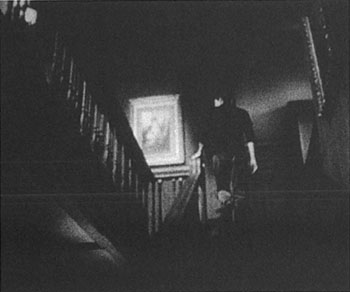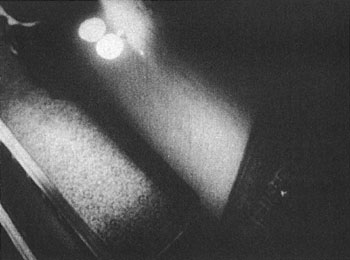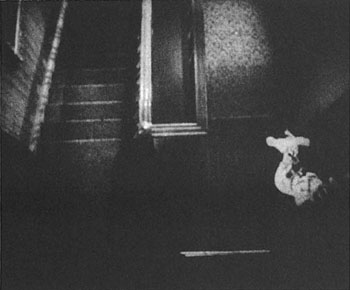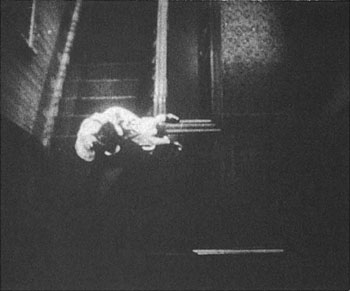
F.T. I was rather intrigued by that fall backward. He doesn’t actually fall. His feet aren’t shown, but the feeling one gets is that he’s going down the stairs backward, brushing each step with the tip of his foot, like a dancer.
A.H. That’s the impression we were after. Do you know how we got that?
F.T. I realize you wanted to stretch out the action, but I don’t know how you did it.
A.H. We did it by process. First I did a separate dolly shot down the stairway, without the man. Then we sat him in a special chair in which he was in a fixed position in front of the transparency screen showing the stairs. ‘Then we shot the chair, and Arbogast simply threw his arms up, waving them as if he’d lost his balance.
F.T. It’s extremely effective. Later on in the picture you use another very high shot to show Perkins taking his mother to the cellar.
A.H. I raised the camera when Perkins was going upstairs. He goes into the room and we don’t see him, but we hear him say, “Mother, I’ve got to take you down to the cellar. They’re snooping around.” And then you see him take her down to the cellar. I didn’t want to cut, when he carries her down, to a high shot because the audience would have been suspicious as to why the camera has suddenly jumped away. So I had a hanging camera follow Perkins up the stairs, and when he went into the room I continued going up without a cut. As the camera got up on top of the door, the camera turned and looked back down the stairs again. Meanwhile, I had an argument take place between the son and his mother to distract the audience and take their minds off what the camera was doing. In this way the camera was above Perkins again as he carried his mother down and the public hadn’t noticed a thing. It was rather exciting to use the camera to deceive the audience.




F.T. The stabbing of Janet Leigh was very well done also.
A.H. It took us seven days to shoot that scene, and there were seventy camera setups for forty-five seconds of footage. We had a torso specially made up for that scene, with the blood that was supposed to spurt away from the knife, but I didn’t use it. I used a live girl instead, a naked model who stood in for Janet Leigh. We only showed Miss Leigh’s hands, shoulders, and head. All the rest was the stand-in. Naturally, the knife never touched the body; it was all done in the montage. I shot some of it in slow motion so as to cover the breasts. The slow shots were not accelerated later on because they were inserted in the montage so as to give an impression of normal speed.
F.T. It’s an exceptionally violent scene.
A.H. This is the most violent scene of the picture. As the film unfolds, there is less violence because the harrowing memory of this initial killing carries over to the suspenseful passages that come later.
F.T. Yet, even better than the killing, in the sense of its harmony, is the scene in which Perkins handles the mop and broom to clean away any traces of the crime. The whole construction of the picture suggests a sort of scale of the abnormal. First there is a scene of adultery, then a theft, then one crime followed by another, and, finally, psychopathy. Each passage puts us on a higher note of the scale. Isn’t that so?